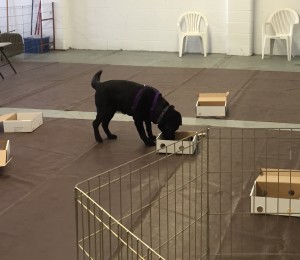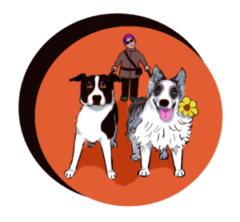 Earlier this month I participated in a Nose Work workshop in Kamloops facilitated by Ann Gunderson . It seemed like a perfect opportunity to observe the teaching part of the workshop while I learned about the topic. I had planned to bring Maxwell, but as it happened, I ended up participating without a dog because of the high temperatures, so that freed up some time and attention for taking notes.
Earlier this month I participated in a Nose Work workshop in Kamloops facilitated by Ann Gunderson . It seemed like a perfect opportunity to observe the teaching part of the workshop while I learned about the topic. I had planned to bring Maxwell, but as it happened, I ended up participating without a dog because of the high temperatures, so that freed up some time and attention for taking notes.
About this Case Study
This case study is simply an account of a workshop event as a way to highlight practices that influence quality and participation. The purpose is to encourage reflection and discussion among dog trainers. As a participant in the workshop, the analysis reflects my own experience.
About the workshop
This was a full weekend of Nose Work workshops that included a choice of a morning or afternoon 4-hour session on Saturday, an evening presentation, and a 4-hour session on Sunday. I participated in the Saturday afternoon session. There were 8 working spots. It took place at Five Star Dog Training facility in downtown Kamloops.
Ann began the workshop by providing an overview of the steps to Scent Detection Training and introducing herself. We then moved into a series of sessions where each working team (handler and dog) took turns working through an exercise. This included odour games using scent placed in boxes, and a shell game and “stop & go” game using scent placed in plumbing fixtures.
Observation notes and analysis
Pre-workshop
Participants registered using an online form. They were asked to select from a list to indicate the dog’s Nose Work experience and trained odours, as well as any anticipated behaviour challenges that might come up during the workshop (e.g. dog reactive/aggressive, human reactive/aggressive, nervous of new places, nervous of flooring, nervous of loud sounds).
In addition, participants were asked to provide some background information about themselves and hopes for the workshop.
Collecting this information in advance of the workshop is helpful in a number of ways:
- Level of expertise in the room — How much time and detail should be devoted to the basics of the subject matter?
- Room set-up — Are there any special considerations for the working space, pathways to and from the working space, proximity to people and dogs, special etc?
- Pacing — Will some working teams require more time? How will this impact the depth and variety of workshop activities?
Preparation
The workshop space was set up in advance, with areas to designate the team working space, presentation and discussions, and dogs. Special consideration was given to the high temperatures.
It was not possible to crate dogs in vehicles. All dogs needed to be crated or contained in an xpen inside the facility. This is where pre-workshop information is very useful. It also emphasizes the need for a Plan B (and C) because there are factors we can’t control, like the weather. Special equipment was needed to provide a comfortable environment (e.g. shade cloths, door props and barriers)
Implementation
Ann began by introducing herself. This included her background working with dogs, the story about how she became interested in Nose Work, and what qualifies her for being there. Most importantly, she expressed her passion for the topic.
The importance of introductions are often overlooked in workshops. In fact, sometimes introductions are omitted completely. Never assume that participants already have this background information! It’s also very valuable as an instructor to situate yourself in the room — people want to know why you are there. Ideally the host of the workshop will handle part of the introductions, as this helps everyone to understand the roles of the individuals involved.
At the beginning of the workshop Ann emphasized that we learn through observation, and how important it is to watch ALL the dogs working. More than once during the afternoon she came back to the point about observation, how each dog is so different, and how behaviour changes in different environments so it’s important to stay tuned in. She pointed out those changes, often with a rhetorical question “Did you notice how Brighty was more engaged when we did x?” What is key here is how well Ann integrated the request for participants’ attention into the curriculum.
 Ann used a whiteboard, especially during the first part of the workshop, to outline the foundational information, and plans for the day(s). She included visuals on the whiteboard to explain concepts, and referred back to them frequently. Ann also listed the dog/handler teams and running order.
Ann used a whiteboard, especially during the first part of the workshop, to outline the foundational information, and plans for the day(s). She included visuals on the whiteboard to explain concepts, and referred back to them frequently. Ann also listed the dog/handler teams and running order.
The use of visuals (whiteboard in this case) seems like a simple idea, but it is not very common in dog training workshops, possibly because the venues don’t come equipped with the drawing
and presentation materials. Something as simple as listing the running order in a place where everybody can see it makes the changeover process much more efficient.
Ann emphasized key points, such as the importance of training in small steps, the pitfalls for taking big leaps, and that you simply need to work with the dog you have. She didn’t spend a great deal of time going into detail. Rather, she relied on questions from participants to fill in any gaps or clarify misunderstandings.
There is so always so much information that can be “covered” in a workshop. However, it is important to consider how much listening participants can do all at once. A format that solicits questions and input from participants might not ensure that all topics are addressed, but it is more likely to keep everyone engaged. Also when dogs are ready and waiting to participate, it is best to move on to working sessions.
Ann used several effective metaphors to explain the training and learning process: ladders for taking small steps and not leaping ahead, and training as a circle — rather than going backwards we are simply moving around the circle. She also told stories, sometimes drawing on her own teaching experiences.
Ann moved quickly into the phase of the workshop where handlers worked with their dogs, and all other participants were observers. She made use of what was going on in the room for distraction training. Also, Ann had clearly thought through the equipment needed to work with dogs safely. In this photograph, rather than work with a fearful dog directly, Ann is coaching Jan from behind a barrier as they work with Ben.
Before we began working with dogs, and each time we moved to a different activity Ann took the time to debrief, and to check in to see if there were any questions. Often Ann would share what she noticed about individual teams, remembering the details of the session and the name of the dog! Then, Ann would outline the next steps — the next activity, or if a break, what time to return. These are small but critical details! Also, Ann would align each activity, and observations with each dog, with the foundational information (e.g. steps to detection training and pathways of the brain).
Throughout the workshop, Ann moved around a lot, used humour, and was animated. She demonstrated actions as she was explaining them. However, she also sat and joined the circle for conversation and questions. This helped to bring people in closer, and listen. I noticed that as the chairs became more spread out, and dogs were working, participants did tend to multi-task. The seating arrangement is key to keeping everyone engaged, but this can be difficult to achieve when participants are also attending to their dogs and needing more space.
Post Workshop
Courtenay Watson from Five Star Dog Training, the organizer and host, followed up with email to thank participants and to provide links and further resources that were mentioned during the workshop.
Summary
Running a workshop requires attention to detail and the ability to think on your feet and adapt. It also takes practice to present material in an engaging way, and to adjust according to the level of expertise and energy in the room — and in this case, the heat! Hopefully these notes from Ann Gunderson’s workshop provide tips and areas for consideration in running your own workshop.


2 thoughts on “Teaching Dog Trainers How to Teach People – A Case Study”